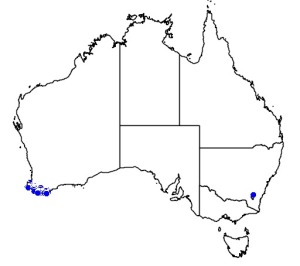Distinguishing features
It has white to cream bark that turns brown as it matures and is shed. The whitish trunk beneath takes on a patina of colours from white to grey to deep brown. The trunk is without secondary trunks, but occasionally a twin trunk occurs where two trunks of the same diameter grow up from the seedling stage. Mature trees branch only from the top third of the trunk. The leaves are dark green on top and lighter underneath, and grow to a length of 90–120 mm and 20–30 mm broad. The cream-colored flowers occur in groups of seven, each flower measuring about 18–28 mm in diameter. Flowering occurs in spring and summer. The fruits are squat and barrel-shaped, with numerous small dry seeds. The fruit is up to a centimeter long. (Wikipedia)
Size
- Up to 8000 cm (Height)
Synonyms
Distribution
Distribution and habitat preferences
It occurs only within the High Rainfall Zone of the South West Botanical Province of Western Australia. It mostly occurs within the Warren biogeographic region, but there are some outlying populations, of which the most notable is in the Porongorup Ranges.
The soil in which they grow is often poor, and the tree tends to flower after fire to take advantage of the nutrients released by the combustion of forest litter. The tree supports an extensive ecosystem which is connected to the granite outcrops of the lower south-west and the many subsequent creeks and rivers created from runoff.
They generally dominate in the deep valleys between granite outcrops surrounding the creeks and rivers. (Wikipedia)

